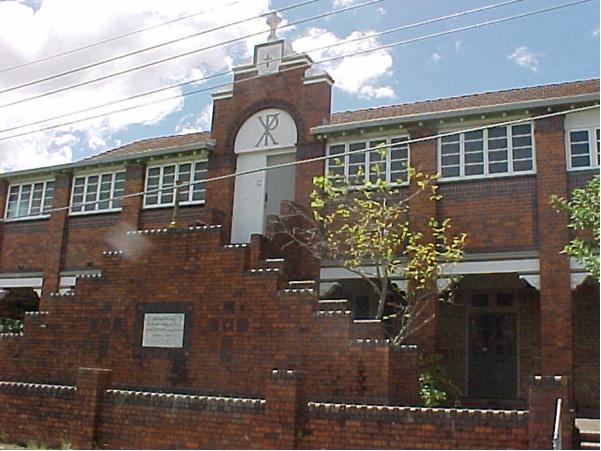Addresses
Type of place
Church, School, Private school
Period
Interwar 1919-1939
Style
Georgian Revival
Addresses
Type of place
Church, School, Private school
Period
Interwar 1919-1939
Style
Georgian Revival
This two-storey brick building was opened by Archbishop Duhig on 3 November 1929 as a church/school for the new parish of Gordon Park. The school, which had a capacity for 200 students, was located on the ground floor of the building, while the church, with a capacity for 250, was located above. In 1976, St. Carthage’s School was closed due to low attendance, however the building continued to be used as a parish and youth centre for the local Catholic community. Like many Catholic precincts developed in Brisbane by Duhig, it commands an elevated position with an excellent view. It was designed in the Georgian Revival style by Brisbane architect, J.P. Donoghue, who also designed the Holy Spirit Catholic Church at New Farm.
Lot plan
L139_SL1463; L137_SL1463; L138_SL1463
Key dates
Local Heritage Place Since —
Date of Citation —
Construction
Roof: Terracotta tile;Walls: Face brick
People/associations
John Patrick (Jack) Donoghue (Architect)Criterion for listing
(A) Historical; (E) Aesthetic; (G) Social; (H) Historical associationInteractive mapping
Lot plan
L139_SL1463; L137_SL1463; L138_SL1463
Key dates
Local Heritage Place Since —
Date of Citation —
Construction
Roof: Terracotta tile;Walls: Face brick
People/associations
John Patrick (Jack) Donoghue (Architect)Criterion for listing
(A) Historical; (E) Aesthetic; (G) Social; (H) Historical associationInteractive mapping
History
This two-storey brick building, designed by Brisbane architect, JP Donoghue, was opened by Archbishop Duhig on 3 November 1929 as a church/school for the parish of Gordon Park. The parish was considered at that time to be one of the most popular and progressive of the new parishes in Brisbane. Gordon Park was previously part of Kedron Parish and Wooloowin Parish. The first parish priest of Gordon Park in 1929 was John McCarthy.
J.P. Donoghue was originally from New South Wales, where he worked for the architectural firm of Hennessy and Hennessy. In 1925-26 he was the Brisbane partner of the firm, then known as Hennessy, Hennessy, Keesing and Co. and J.P. Donoghue. From 1926-1937, Donoghue had his own practice in Brisbane. Other churches he designed include the Holy Spirit Church in New Farm (1930). Donoghue died in 1960.
The building was designed with a school capable of accommodating around 200 children on the ground floor and a church situated above with a capacity of 250. The intention was to eventually use both floors as a school when a new church was built. The church/school, presbytery, furnishings and the four allotments which made up the site cost a total of £4,498. The presbytery was formerly a private home. The contract for the building of the church was given to Concrete Constructions, who had recently completed the foundations of the planned Holy Name Cathedral. The foundation stone of the church/school was laid by Archbishop Duhig on 28 July 1929.
The parish school opened in July 1930, with 29 students under the tutelage of the Sisters of Mercy who travelled daily from the Holy Cross Convent at Wooloowin. Numbers at the school increased quickly to 79 later in the year. The school’s population was boosted again when students from the Stafford Parish attended while their own school was constructed. The interwar years were a period of rapid growth in Gordon Park. As was the case with many Catholic and secular schools, unemployed labour was used to level the school grounds during the years of the 1930s depression. Men of the parish were among those who worked in the grounds under this scheme.
On 26 June 1966 a new church and presbytery was opened by Archbishop Patrick O’Donnell. The new buildings were designed by architects Corbett and Ryan and cost over $92 000, including furnishings.
From 1975, the teaching staff of St. Carthage’s School were led by a lay principal, Mr. E. Pender. It was one of the first schools in the Archdiocese of Brisbane to be controlled and staffed with lay teachers. The school closed at the end of 1976 as the number of students (86) was considered by the Brisbane Catholic Education Office to be financially unviable. After the closure of the school, the building was used as a youth centre for the Deanery and parish venue for social and indoor sporting activities.
The St. Carthage’s school was a focus of Catholic worship, education and social activity for the local Catholic community for more than half a century.
Statement of significance
Relevant assessment criteria
This is a place of local heritage significance and meets one or more of the local heritage criteria under the Heritage planning scheme policy of the Brisbane City Plan 2014. It is significant because:
References
-
Brisbane City Council Water Supply & Sewerage Detail Plans
-
Catholic Advocate. 7 November 1929
-
Catholic Archives. St. Carthage’s Parish file
-
St. Carthage’s Parish, Gordon Park: Golden Jubilee 1929-1979. np. 1979
-
Telegraph. 4 November 1929
Citation prepared by — Brisbane City Council (page revised June 2022)

